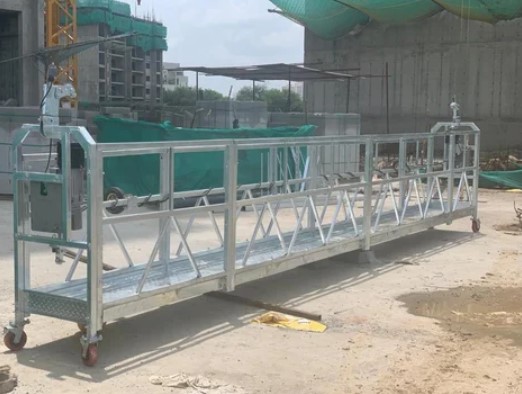Introduction
The Impact of Advanced Materials on the Durability
In the realm of high-rise construction and maintenance, the suspended platform cradle is a vital piece of equipment. Ensuring the durability and safety of these cradles is paramount. Advances in material science have significantly enhanced the durability and performance of suspended platform cradles, making them safer and more reliable. This article explores the impact of advanced materials on these critical devices.
Evolution of Materials in Suspended Platforms
Traditional Materials and Their Limitations
This kind of Platform cradles were constructed using materials such as wood and steel. While these materials provided the necessary strength, they came with significant limitations. Wood, though strong, was susceptible to rot and insect damage, while steel, although durable, was heavy and prone to rust and corrosion, especially in harsh weather conditions.
The Shift to Aluminum and Alloys
The introduction of aluminum and its alloys marked a significant improvement in the construction of suspended platform cradles. Aluminum is lightweight, corrosion-resistant, and strong, making it an ideal material for high-rise maintenance equipment. These properties not only enhanced the performance but also extended the lifespan of the cradles. Read more about hanging scaffold systems here.
Advanced Materials Enhancing Durability
High-Strength Alloys
In these platform cradles often utilize high-strength alloys that combine the best properties of different metals. These alloys are engineered to provide superior strength-to-weight ratios, enhancing both the durability and the ease of handling of the cradles. They resist wear and tear better than traditional materials, leading to longer service life and reduced maintenance costs.
Composite Materials
Composite materials, such as fiber-reinforced polymers (FRPs), have revolutionized the design of suspended platform cradles. These materials offer exceptional strength and durability while being significantly lighter than metal counterparts. Composites are resistant to corrosion, UV radiation, and chemical exposure, making them ideal for use in various environmental conditions.
Nanomaterials and Coatings
The application of nanomaterials and advanced coatings has further improved the durability of suspended platform cradles. Nanocoatings can provide a protective barrier against environmental factors such as moisture, salt, and chemicals, which can cause corrosion and degradation. These coatings enhance the lifespan of the cradles, ensuring they remain in optimal condition for longer periods.
Benefits of Advanced Materials
Enhanced Safety
The use of advanced materials in the construction of suspended platform cradles directly translates to enhanced safety for workers. High-strength alloys and composites reduce the risk of structural failure, while advanced coatings protect against environmental damage, ensuring the platform remains secure and reliable.
Increased Longevity
Advanced materials significantly increase the longevity of this platform cradles. Materials like high-strength alloys and composites do not degrade as quickly as traditional materials, meaning the equipment requires less frequent replacement. This not only reduces costs but also minimizes downtime.
Read also: Random Video Chats: Breaking Down Cultural Barriers Through Technology
Cost-Effectiveness
While the initial cost of advanced materials might be higher, the long-term benefits are substantial. Reduced maintenance requirements, longer service life, and enhanced performance mean that suspended platform cradles constructed from advanced materials offer better value over their lifespan.
Case Studies
High-Rise Building Maintenance
In high-rise building maintenance, suspended platform cradles made from advanced materials have demonstrated superior performance. For example, a leading construction company reported a 30% reduction in maintenance costs and a significant increase in operational safety after switching to aluminum and composite cradles.
Offshore Oil Rigs
In the challenging environment of offshore oil rigs, the durability of this platform cradles is put to the test. Using composites and advanced coatings, these cradles withstand harsh conditions, such as saltwater exposure and extreme weather, proving the effectiveness of advanced materials in extending equipment lifespan and ensuring safety.
Future Prospects
Innovations in Material Science
This kind of platform cradles lies in continued innovations in material science. Research into new composites, alloys, and nanomaterials promises to further enhance the durability, safety, and performance of these critical devices. Future materials will likely offer even greater strength, reduced weight, and enhanced resistance to environmental factors.
Sustainable Materials
As sustainability becomes increasingly important, the development of eco-friendly materials for suspended platform cradles is gaining traction. Recyclable composites and green manufacturing processes will not only improve the durability and performance of the cradles but also reduce their environmental impact.
Conclusion
The impact of advanced materials on the durability of suspended platform cradles is profound. By incorporating high-strength alloys, composites, and nanomaterials, manufacturers have significantly enhanced the safety, longevity, and cost-effectiveness of these essential tools. As material science continues to evolve, we can expect even greater advancements, ensuring that suspended platform cradles remain reliable and durable in the face of ever-increasing demands.


